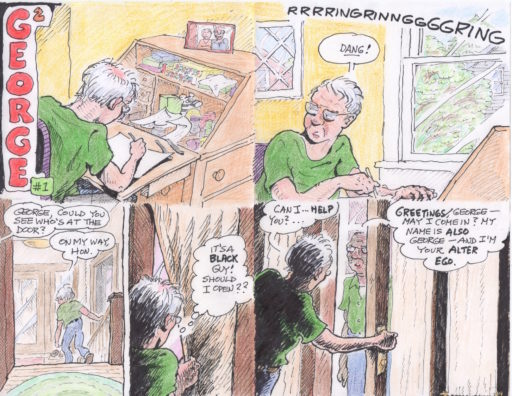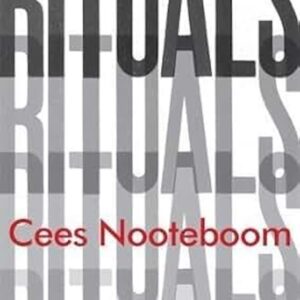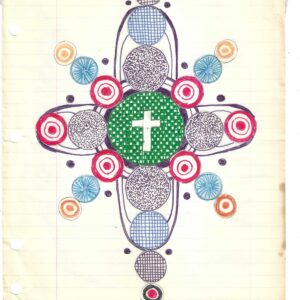I sat before my drawing board and drew a blank.
Then I really did draw a blank, and the story began….
But first let’s go back a bit. My friend Steve had asked me to write a graphic novel about White Privilege. He thought of it as a discussion starter for groups wanting to tackle that prickly topic. (“Prickly”? Try “barbed.”)
The wiser part of me thought, “Probably not a good idea.” But then I remembered an incident from my early teen years when I and a pal—white, like me—had taunted two young Black nurses with racial slurs. The memory still troubled me more than sixty years later. The risk-taker in me said, “Here’s your final chance to deal with this issue. You won’t get another one.”
So I sat before my drawing board and drew that blank I talked about. Meaning, I didn’t know where or how to start. It was easy enough to say: “I want to deal with this issue,” but an issue is not a story. An issue may provoke a story, and memory may supply some details. A story is something else.
As George Saunders so persuasively reminds us, in his engaging book about storytelling, A Swim in a Pond in the Rain, a story is a way for a writer and a reader to think and imagine together. Whatever personal or therapeutic value telling a story may have for the writer, its fullest value emerges only when a reader, any reader, even just one reader, realizes something like that value for herself as well. “We imagine a story as a room-sized black box,” says Saunders. “The writer’s goal is to have the reader go into that box in one state of mind and come out in another. What happens in there has to be thrilling and non-trivial.”
Saunders isn’t talking about writers and readers in the abstract. That’s the beauty of his book. An acclaimed short story writer and novelist himself (his novel, Lincoln in the Bardo, is a Man Booker Prize winner), Saunders turns A Swim in a Pond in the Rain into an amplified version of a class in short story writing he’s been offering for years at Syracuse University.
Putting it that way may make the book sound as if it’s meant mainly for students who tried hard to get into that class but got closed out. (Tough luck, kids, but here’s the next best thing.) And partly that’s true, at least in the sense that any student wanting to ignite her passion for and understanding of the short story form would benefit from this book. But Saunders is casting a wider net. He’s treating every reader like a writer. He’s treating every reader as if she herself could be Chekhov, Turgenev, Gogol, and Tolstoy, seven of whose short stories provide the focus for our class.
As a former English teacher in both college and high school settings, I was wary at first but then quickly won over by Saunders’ refusal to observe the usual divisions between readers and writers (between passive and active, receptive and creative). Saunders’ understanding of the short-story form as an opportunity for shared imaginative spontaneity between two minds, the writer’s and the reader’s, operating in full freedom— this made the distance between the penning or keyboarding of words and the attentive comprehending of them shrink to…to…shrink to nothing? The reader and the writer become one?
Well, no. I am not Anton Chekhov, last I looked. Yet as Saunders, in his first chapter, takes me one page at a time through Chekhov’s story “In the Cart,” pausing after each page to assess what exactly we readers are being asked to imagine about Marya Vasilyevna, Semyon the driver, and Hanov the landowner, and how what we imagine subtly changes as we move from one page to the next—as he does so, I begin to grasp, first, that the act of writing includes an act of reading. Every word Chekhov wrote in that particular place, on that particular page, resulted from a combination of inspiration and consideration, from a creative impulse followed by a creative assessment of what resulted. And second, I begin to grasp that the better the writer-as-reader, the better the reader-as-writer. The more attentively the writer reads what she has written, the better the writing— where “better” refers to the likelihood that whatever she’s written will stimulate and delight any other reader.
Saunders puts the point this way, again referring to his black-box metaphor:
The kind of intuitive, line-by-line attention to editing we’ve been talking about— that’s what makes it more likely that what happens in there [i.e. the black box] will happen more crisply and definitively. And since, in every decision, I’m proceeding by the question, “Does this delight me?” there should be some delight in there for you too.
Saunders was probably just beginning A Swim in a Pond in the Rain when I drew that blank at the start of my graphic novel on White Privilege. But I feel as if I’d somehow already caught the drift of his message about story telling. That’s because, having drawn that blank, I stepped back from the blank, assessed it, and drew it again, on the blank page in front of me. I drew myself from over my shoulder. There I was, hunched over my drawing board with a blank sheet of paper in front of me. That was Panel #1. Are you with me, reader? Have I included you? Of course I have: You’re the one standing right in back of me. You’re the “I” watching over my shoulder. You’re waiting to see what that guy in the drawing is going to do next. You have no confidence in him, and neither do I. Anything that dope scribbles onto his page right now will be forced, labored, false. So: Panel #2. A doorbell rings. Saved by the bell! Oldest trick in the book, and it works, for the dope is up and running, glad he’s off the hook. You follow him down the stairs because he has so lamely and literally turned his back on the challenge of addressing his White Privilege. You’re right behind him as he gets to the front door. Who can it be? You’re right behind him as he peeks through the curtain. Uh-oh. An Unknown Black guy! The dope timidly opens the door just a crack (can’t be too careful with Unknown Black guys at the door). Last Panel, the “hook” panel, the one that needs to make you, the reader, want to turn the page. “Hello, George. I’m your alter ego.”
And we’re off.
After getting his PhD in English literature, George Dardess taught close reading to his own students until his retirement. Since then he has been ordained a Deacon in the Roman Catholic Church and written several books on Muslim-Christian relations. He has also created the graphic novel Foreign Exchange.





